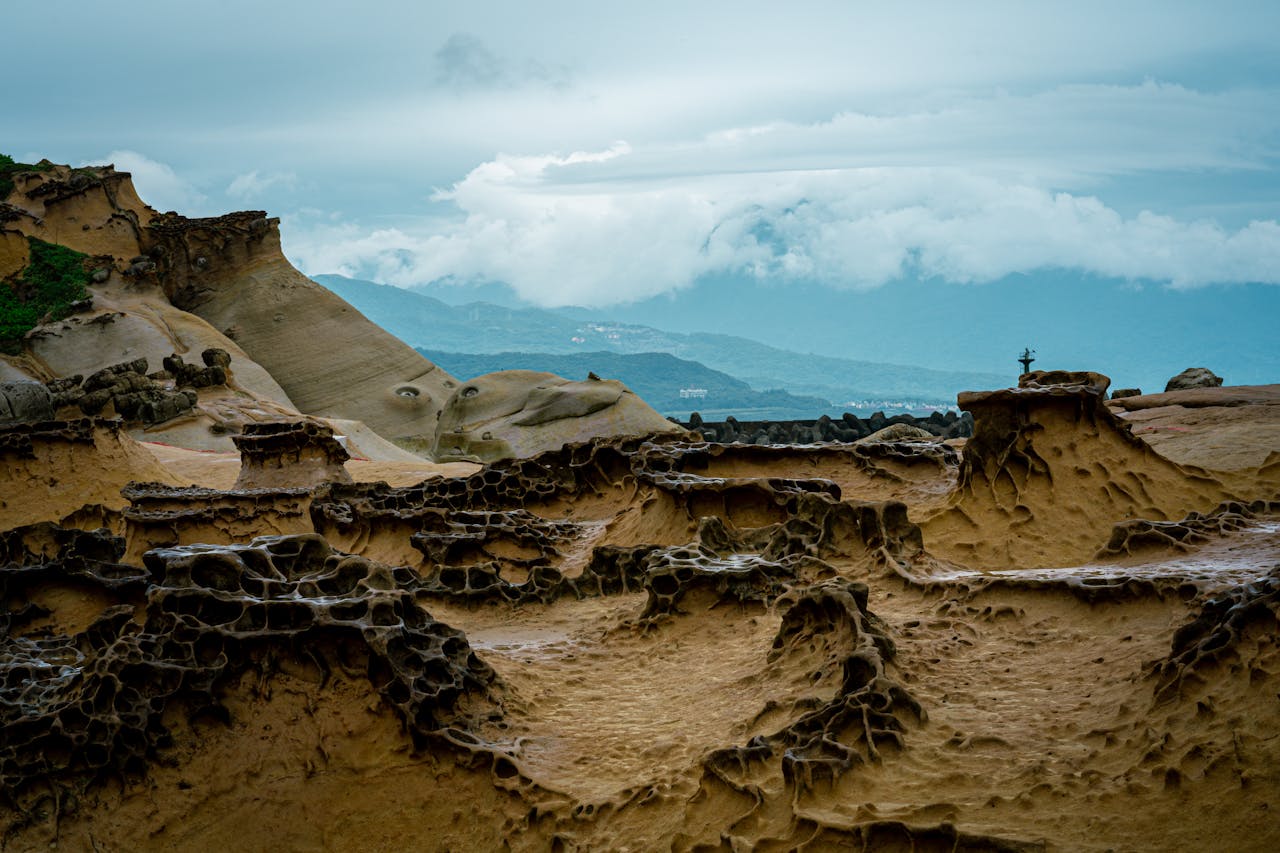UNESCO’s Executive Board has endorsed the addition of 18 sites to the UNESCO Global Geoparks network. This brings the total number of geoparks to 213 in 48 countries.
The new geoparks are situated in Brazil, China, Croatia, Denmark, Finland, France, Greece, Hungary, Poland, Portugal and Spain. There is an additional new transboundary geopark spanning Belgium and the Kingdom of the Netherlands.
The UNESCO Global Geopark designation was created in 2015. It recognizes geological heritage of international significance. Geoparks serve local communities by combining the conservation of their significant geological heritage with public outreach and a sustainable approach to development. UNESCO continues to promote the geopark concept in regions where geoparks are less common, notably in Africa, the Arab States and Small Island Developing States. UNESCO does this by facilitating expert missions, tailored training sessions and individual consultations on both a national and local scale, to guide the preparation of applications for UNESCO Global Geopark status.
The newly designated UNESCO Global Geoparks are:
Belgium and Kingdom of the Netherlands: Schelde Delta UNESCO Global Geopark
Schelde Delta UNESCO Global Geopark holds a unique geological position between the sinking North Sea Basin and the rising Brabant Massif. Geological forces, climate-driven environmental change and human interactions have forged a landscape rich in geological, morphological and cultural–historical traces. The lowlands, protected by dykes, are starved of sediment and, wherever they have been left untouched, seem almost frozen in time. Historic constructions bear testimony to the influence of different geological phases.
The geopark uses a multifaceted narrative that interweaves geological and human history to raise awareness about the region’s critical vulnerability to climate change. The geopark shows “on a small scale what the effects of climate change and sea level rise are worldwide", observes local photographer and artist Rem van den Bosch. One current conservation project aims to resurrect the lost medieval town of Reymerswael, which was submerged in 1530 by peat excavation. The endeavour combines coastal defence, water-quality preservation and ecological enrichment of the Eastern Scheldt, underscoring the geopark's commitment to holistic environmental preservation.
Brazil: Uberaba UNESCO Global Geopark
Located within South America’s second largest biome, in southeast Brazil, lies the Uberaba UNESCO Global Geopark. Impressive prehistoric landmarks include the Serra da Galga and Serra Geral formations. They sport basalt flows that record volcanic events preceding the fragmentation of the Gondwana supercontinent and the opening of the South Atlantic Ocean. These basalt flows cover the sedimentary rocks of the Botucatu Formation, which hosts one of the world's largest freshwater reserves. The aquifer which gives the region its name is derived from the early Tupi term Y-berab, meaning “clear water”.
The geopark’s tag line ‘Land of the Giants’ refers to its rich palaeontological heritage. Over ten thousand fossils have been discovered in the territory, including dinosaurs, crocodyliforms, turtles and a myriad of other prehistoric creatures. Notably, the fossil of Uberabatitan ribeiroi, a dinosaur measuring 27 meters in length and 10 meters in height, is the largest ever discovered in Brazil.
The social, cultural and economic development of the region is largely attributed to the pioneering spirit of the local farmers who introduced the Zebu cattle breed in the late 19th century. Not only did this revolutionise the Brazilian livestock market but it also serves today as an international reference point for cattle-breeding that produces lower CO2 emissions.
China: Enshi Grand Canyon-Tenglongdong Cave UNESCO Global Geopark
Enshi Grand Canyon-Tenglongdong Cave UNESCO Global Geopark lies in the southwest of Hubei Province. The geopark is home to world-famous erosion and dissolution landscapes and the rich cultural heritage of the Tujia, Miao, and Dong ethnic minority groups.
The geopark's geological marvels unfold across exposed strata ranging from the Cambrian to the Cretaceous periods (approximately 539 to 66 million years ago). The topography is deeply dissected by the Qingjiang river system, forming a spectacular karst landscape in Permian and Triassic carbonate rocks characterized by steep cliffs, deep gorges, caves, and disappearing rivers. The periodic uplift of the Qinghai-Tibetan Plateau by tectonic collision formed several planation surfaces and resulted in the world-renowned multi-level Tenglongdong Cave system and Enshi Grand Canyon. The geological landscape supports remarkable biodiversity, with lush forests covering an astounding 67.3% of the geopark, an area of over 450 km². There are more than 4,000 plant species and 500 different terrestrial vertebrates in the geopark.
Beyond the geopark’s geological splendour, the rich cultural heritage of the Tujia, Miao and Dong ethnic minority groups lies at the heart of the territory. Visitors can experience traditional architecture, folk songs, dances and festivals which enrich their understanding of the region's cultural fabric.
China: Linxia UNESCO Global Geopark
Linxia UNESCO Global Geopark is located in the Gansu Province. It features a landscape characterised by mid-high mountains, hills and basins. The area played a significant role in China's early historical and cultural development.
The dramatic Danxia landform along the Yellow River showcases striking colourful rock formations shaped by erosion, weathering and gravity. The geopark is home to the famous Bingling Cave Temple grottoes, where intricate sculptures are carved into the cliff faces, and to one of the longest and best-preserved fossil trackways on record, 24 consecutive paired footprints of the pterosaur, the earliest vertebrate species known to have evolved powered flight. The geopark is the region with most abundant ancient mammal fossils in China.
With roots tracing back more than 5,000 years along the Yellow River, Linxia was an important courier station along the Ancient Silk Road. The Gansu province is world-famous as the birthplace of the Hua’er folk music tradition shared by nine ethnic groups and inscribed on UNESCO’s Intangible Cultural Heritage list. The Hua’er music is drawn from an extensive traditional repertoire and provides a fascinating, vivid oral record of recent social developments in China as singers comment on the changes they observe around them.
China: Longyan UNESCO Global Geopark
Longyan UNESCO Global Geopark offers a geological record of tectonic evolution in southeast China covering a period of approximately 300 million years. The geopark’s abundant geological heritage includes the Meihuashan granitic complex, the Guanzhaishan red bed sedimentary rocks and the Zijinshan super-large porphyry-epithermal copper–gold deposit.
Home to the densest natural forests of West Fujian, the geopark displays rich biodiversity. The forest coverage of Meihuashan Mountain reaches 95.4%. It is described locally as the “Mother Mountain of the Fujian Province”. The geopark is home to endemic animal and plant species, including the Panthera tigris amoyensis (South China tiger) and the rare Taxus chinensis var. Mairei (Chinese Yew).
Longyan is the birthplace of the Hakka culture. Many unique traditions endure to the present day, including the “You Da Long”, where locals dance in a large dragon formation, the “Zou Gu Shi”, where locals wear traditional clothes and take part in a carnival, and the art of woodblock printing. The Peitian Landscape Roundhouses display the architectural style of the Hakka culture, arranged compactly along long cobbled streets.
China: Mount Changbaishan UNESCO Global Geopark
Located in the southeast Jilin Province, Mount Changbaishan UNESCO Global Geopark is like an open-air classroom for volcanism, with dramatic landforms and diverse rock types that document significant multiphase eruptions. The ‘millennium eruption’, which took place around 1,000 years ago, is one of the largest volcanic eruptions in modern history and has left a lasting impact, creating special pyroclastic accumulations of international significance.
Mount Changbaishan itself is one of the best-preserved composite volcanoes from the past several million years.It records the complete formation of the volcano, allowing for the study of the processes at work in the formation of volcanoes. At its summit, you will find the highest and largest crater lake in northeast Asia, the Tianchi Lake, which offers breathtaking views.
Most recently, the geopark has been working on a comprehensive restoration of the freshwater ecosystem at the source of the Songhuajiang River. The geopark works closely with local communities to promote sustainable tourism and facilitate environmental restoration projects.
China: Wugongshan UNESCO Global Geopark
Wugongshan UNESCO Global Geopark is located at the junction of three cities, Pingxiang, Yichun, and Ji'an, in the west of Jiangxi Province. It is characterized by fascinating geological landscapes including Jurassic (ca. 201- to 145-million-years-old) granite 'stone forests’, alpine meadows growing on the weathered Silurian (ca. 444- to 419-million-years-old) granitic gneiss and hot springs. The geopark is rich in well-preserved geological heritage, making it a crucial site for studying the early formation of the South China Block and subsequent intracontinental compression and extension.
The geopark has developed a host of creative initiatives to promote geotourism, in order to strengthen the connection between local communities and the unique landscape. The large-scale tent festivals attract thousands of campers and promote outdoor activities such as mountain bike racing and bonfire carnivals. Another way to experience the landscape is by taking an agricultural tour of orchards and tea gardens, with a particular focus on picking.
China: Xingyi UNESCO Global Geopark
Located in Guizhou Province, Xingyi UNESCO Global Geopark is a geological treasure trove with imposing natural scenery such as the Malinghe River Gorge, bursting with over 100 cascading waterfalls during periods of heavy rain. The Wanfenglin site displays more than 20,000 karst peaks, stretching as far as the eye can see, and was chosen as one of the four scenic spots in China to be honoured on a postage stamp in 2013.
The geopark is world-famous for the exceptionally preserved "Xingyi fauna" from the late Ladinian Age (ca. 242 to 237 million years ago). These marine reptile and fish fossils offer an unparalleled glimpse into the transition of marine life from nearshore habitats to the deep ocean. It is the only paleo-fauna site to preserve entirely the turnover of marine reptiles from the Ladinian Age to the Carnian Age (ca. 237 to 227 million years ago).
The geopark is home to various ethnic minority groups, including the Buyi, Miao, Yi, Hui, Gelao and Shui. Among them, the Buyi people are predominant, known for their expertise in weaving, batik printing, brocade work and embroidery.
Current projects in the geopark include the Wanfu Qixing Bee Farm cooperative, which supports individuals with disabilities and their families through the production and sale of honey, and the Lüyuan Flower Base, a centre focused on research, cultivation and education related to orchids and other endangered plant species. There are over 2.5 million orchid seedlings and 50,000 endangered plants in the database.
Croatia: Biokovo-Imotski Lakes UNESCO Global Geopark
The Biokovo-Imotski Lakes UNESCO Global Geopark is situated in central Dalmatia. It sits at a unique intersection of Mediterranean and Central European landscapes and cultures. At the heart of the geopark lies the Biokovo Mountain sporting the third-highest peak in Croatia, St George Peak, reaching 1762 m above sea level. The Vrljika River winds through the fertile Imotski Region, providing locals with vital freshwater sources and excellent conditions for agriculture; it is known locally as the ‘source of sustenance’. The geopark’s natural wonders also include the Red Lake, Europe’s deepest karst lake, formed from the collapse of a massive doline, or sinkhole, and the picturesque Blue Lake, renowned for its crystalline waters. Rich in cultural heritage, the geopark is home to several hundred archaeological sites dating from antiquity to the Middle Ages, including medieval Stećak tombstones.
Embracing sustainable tourism, the geopark collaborates closely with local stakeholders, promoting eco-friendly practices and supporting community-based initiatives. Associations like Ričice work to enhance the region's biodiversity and foster sustainable development. Currently, the geopark is leading efforts to conserve water bodies within the Croatian karst mountains, safeguarding vital ecosystems for future generations. Biokovo-Imotski Lakes UNESCO Global Geopark works cooperatively with UNESCO Global Geoparks in Serbia, Slovenia and Austria, sharing knowledge about geoheritage, geodiversity and the development of geotourism.
Denmark: The South Fyn Archipelago UNESCO Global Geopark
The South Fyn Archipelago UNESCO Global Geopark in the central and southern parts of the country encompasses both terrestrial and marine zones that transcribe approximately 800,000 years of geological history. The area is renowned for its beautiful, hilly landscapes, lush fields and some of the best sailing waters in the world.
The South Fyn Archipelago itself encompasses 55 islands and islets, poking up from one of the world’s most spectacular inundated glacial landscapes. Each island is unique, with its own traditions and cultures, whereas all are connected by the common maritime history of the area. According to Laura J. Storm, islander and volunteer on the Island Council, the geopark “cultivates a spirit of community and collaboration among the islands”. There is a continuous focus on preservation and restoration of the marine ecosystem in the archipelago, which is threatened by environmental changes.
The geopark territory has a long history of farming and agriculture. Historically, the island of Fyn has been named “The Garden of Denmark”. Today, the area boasts many small farms and producers and the geopark has created a network for local business owners.
Finland: Impact Crater Lake – Lappajärvi UNESCO Global Geopark
Impact Crater Lake - Lappajärvi UNESCO Global Geopark is located in South Ostrobothnia in the west of the country. The centrepiece of geological intrigue is the Lappajärvi Impact Crater Lake itself, recognized as Europe's largest impact crater lake, which formed through a collision with a meteorite 78 million years ago. Visitors are invited to discover this fascinating history through interactive displays, whether by touching the actual rocks of the meteorite collision, including diamonds that formed from the ultra-high pressure of the meteorite impact, or by embarking on a virtual reality journey into the asteroid belt to witness the collision.
The geopark works closely with the local community to promote sustainable development and economic wellbeing. Natural products and fish from the Impact Crater Lake are used in school meals, and cooperation with schools brings added value to the geopark ecosystem.
France: Armorique UNESCO Global Geopark
From the vertical cliffs of the Crozon Peninsula to the Arrée Mountains, the Armorique UNESCO Global Geopark offers a journey through more than 500 million years of geological history. It tells the story of an ancient sea, the sediments of which later formed a mountain range; 320 million years ago, the Armorique territory was as high as the modern-day French Alps. The geopark is promoting the remarkable geodiversity of the region, which includes a diverse array of lithological, structural and palaeontological formations, including the largest bay in Europe, Brest Bay, 180 km in width, and an impressive granitic boulder field in the Huelgoat forest.
Local legends abound, alongside archaeological remains and traditional architecture that makes full use of locally sourced rocks. The geopark organizes educational walks and produces pedagogical resources for local schoolchildren, in French, English and in the local Breton tongue, with titles such as ‘Let the stones speak! What secrets do they reveal?’ Its residents are proud to be developing and maintaining a distinct maritime, peninsular and mountain identity.
France: Normandie-Maine UNESCO Global Geopark
Normandie-Maine UNESCO Global Geopark lies within a peaceful pastoral region that is rich in hamlets, villages and meadows and reaches into the departments of both Normandy and the Pays de la Loire.
Amid the tranquility, you will find remarkable remnants of a geological history spanning 600 million years, including rocky escarpments, sheer cliff drops, white-water rapids and ancient megalithic sites. Over 300 million years ago, this area was near the equator and witnessed the formation of the Armorican Massif, which reached heights of over 4,000 meters, before gradually eroding into the landscape seen today. The territory has born witness to the formation of two mountain ranges and the creation of the subsident sedimentary basin known as the Paris Basin.
Today, the geopark is actively collaborating with local stakeholders to preserve and promote this unique territory. Through the restoration of 120 hectares of moorland and 10 hectares of peat bogs, the geopark has supported fragile ecosystems, home to species that include the Hen Harrier (Circus cyaneus) and European Nightjar (Caprimulgus europaeus) bird species. By fostering community involvement, including that of local residents, elected officials and associations, the geopark is ensuring the effectiveness and long-term sustainability of its conservation efforts.
Greece: Meteora Pyli UNESCO Global Geopark
Nestled within the picturesque Thessaly region at the centre of mainland Greece, the Meteora Pyli UNESCO Global Geopark is famed for the towering Meteora sandstone columns that reach heights of up to 300 meters. Perched atop these 'columns of the sky' are the iconic Byzantine monasteries, constructed between the 13th and 16th centuries. They are adorned with 16th-century frescoes, which mark a key stage in the development of post-Byzantine painting and offer an insight into the region's rich religious history and artistic heritage.
Among the other geological wonders of the geopark are the Tafoni formations of Kalambaka, with honeycomb weathering patterns carved into the rock by millennia of erosion. In the western part of the geopark, the Pindos mountains offer a haven for biodiversity and outdoor enthusiasts with rugged peaks, alpine meadows, lush forests and meandering rivers. Trekking through the region's unique terrain, visitors can encounter rare plant species, including the Chalcedonian lily (Lilium chalcedonicum) and the endemic chasmophyte Centaurea kalambakensis which thrive in the area's distinct microclimates.
Hungary: Bükk Region UNESCO Global Geopark
The Bükk Region UNESCO Global Geopark in northern Hungary lies in one of the country’s most complex geological environments and comprises a near-continuous sedimentary sequence spanning more than 300 million years, punctuated by periods of volcanic activity. Geological highlights include the unique Bálvány North geological key section recording the Permian-Triassic boundary ca. 252 million years ago, pillow basalt lavas formed during deep-sea volcanic eruptions, and distinctive beehive rocks linked to Miocene volcanism. The geopark is home to diverse karst formations, exemplified by nearly 1,150 caves, over a quarter of all the caves in Hungary, including the Szeleta Cave which was inhabited for 130,000 years and which gave the name to the Szeleta culture.
The region's rich biodiversity includes insect fauna, cave-dwelling bat species and a variety of birdlife, including rare species such as the short-toed snake eagle (Circaetus gallicus), imperial eagle (Aquila heliaca), black stork (Ciconia nigra), and white-throated dipper (Cinclus cinclus).
Poland: Land of Extinct Volcanoes UNESCO Global Geopark
Situated in the scenic southwest, the Land of Extinct Volcanoes UNESCO Global Geopark encompasses the Kaczawskie Mountains and surrounding foothills. The geopark features distinctive remnants of Paleozoic and Cenozoic volcanoes and lava flows, predominantly from the Oligocene and Miocene (ca. 35 to 15 million years ago), with impressive examples of columnar jointing. Mount Ostrzyca, with its conical basaltic neck, stands as the area's most recognizable landmark.
The territory’s history is closely linked to its mineral resources, with a long tradition of gold and copper prospecting. Abandoned quarries serve as invaluable windows into the area's geological and cultural past. The former basalt quarry, Wilcza Góra, stands as a testament to recent community-driven conservation and innovation, as it has been reclaimed for scientific and educational purposes.
In line with its commitment to sustainable tourism and economic sustainability for local communities, the geopark offers an Explorer's Passport programme whereby tourists can collect stamps and stickers by visiting participating local establishments, with the opportunity to earn a medal crafted by a local artisan.
Portugal: Oeste UNESCO Global Geopark
The Oeste UNESCO Global Geopark, located along Portugal's central west coast, encompasses over 72 km of Atlantic coastline, with more than 15 km of sandy beaches. The coastline exposes geological layers that date back to the late Triassic Period, about 230 million years ago, and extend to the Holocene Era (since 11,700 years ago), a time which saw the opening of the North Atlantic Ocean. Today, the coastline plays a crucial role in sustaining local communities through fishing, with several small ports dotting the shoreline. The unique craft of Peniche bobbin lacemaking was traditionally practiced by the wives of fishermen.
The Oeste Geopark has an exceptionally rich palaeontological heritage, with over 180 fossil sites including the remains of 12 distinct dinosaur species. The geopark is home to two sites of fossilized dinosaur nests with embryos, of which there are only 12 world-wide.
Spain: Calatrava Volcanoes. Ciudad Real UNESCO Global Geopark
Calatrava Volcanoes. Ciudad Real UNESCO Global Geopark is situated in the southwest of the autonomous community of Castilla-La Mancha, in central Spain. The geopark territory offers a chronological thread of distinctive volcanic episodes that defines the landscape.
The geopark houses the world's most prolific mining reservoir for mercury, in the region of Almadén, which has been extracted for over 2,500 years. Here you can find the only mercury mine in the world to have been exploited from Roman times to the present day. The strong presence of mercury is due to a submarine Surtseyan volcanic eruption which occurred 420 million years ago. The Puertollano area of the geopark has been named the Palaeobotanical Pompeii of the planet, for its exceptional plant and animal fossils preserved by a major volcanic eruption that occurred 300 million years ago. Finally, a new volcanic pulse began (ca. 7.4 to 0.7 million years ago) that resulted in the creation of a multitude of strombolian and hydromagmatic edifices, making the area a boon for planetary and astrobiological research thanks to its similarities to landscapes on Mars.
The relationship between humans and the volcanic igneous environment has been direct and dependent: the basic socio-economic resources were subordinated to the fertility of its volcanic soils, to the constructive qualities of its volcanic rocks and to the mining wealth of its subsoil. The geopark also encompasses landscapes mentioned in Cervantes' novel Don Quixote.






































